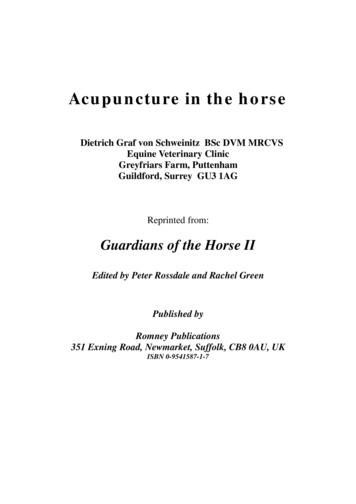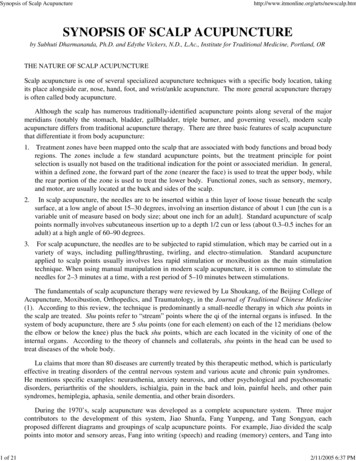
Transcription
Synopsis of Scalp Acupuncture1 of IS OF SCALP ACUPUNCTUREby Subhuti Dharmananda, Ph.D. and Edythe Vickers, N.D., L.Ac., Institute for Traditional Medicine, Portland, ORTHE NATURE OF SCALP ACUPUNCTUREScalp acupuncture is one of several specialized acupuncture techniques with a specific body location, takingits place alongside ear, nose, hand, foot, and wrist/ankle acupuncture. The more general acupuncture therapyis often called body acupuncture.Although the scalp has numerous traditionally-identified acupuncture points along several of the majormeridians (notably the stomach, bladder, gallbladder, triple burner, and governing vessel), modern scalpacupuncture differs from traditional acupuncture therapy. There are three basic features of scalp acupuncturethat differentiate it from body acupuncture:1. Treatment zones have been mapped onto the scalp that are associated with body functions and broad bodyregions. The zones include a few standard acupuncture points, but the treatment principle for pointselection is usually not based on the traditional indication for the point or associated meridian. In general,within a defined zone, the forward part of the zone (nearer the face) is used to treat the upper body, whilethe rear portion of the zone is used to treat the lower body. Functional zones, such as sensory, memory,and motor, are usually located at the back and sides of the scalp.2.In scalp acupuncture, the needles are to be inserted within a thin layer of loose tissue beneath the scalpsurface, at a low angle of about 15–30 degrees, involving an insertion distance of about 1 cun [the cun is avariable unit of measure based on body size; about one inch for an adult]. Standard acupuncture of scalppoints normally involves subcutaneous insertion up to a depth 1/2 cun or less (about 0.3–0.5 inches for anadult) at a high angle of 60–90 degrees.3.For scalp acupuncture, the needles are to be subjected to rapid stimulation, which may be carried out in avariety of ways, including pulling/thrusting, twirling, and electro-stimulation. Standard acupunctureapplied to scalp points usually involves less rapid stimulation or moxibustion as the main stimulationtechnique. When using manual manipulation in modern scalp acupuncture, it is common to stimulate theneedles for 2–3 minutes at a time, with a rest period of 5–10 minutes between stimulations.The fundamentals of scalp acupuncture therapy were reviewed by Lu Shoukang, of the Beijing College ofAcupuncture, Moxibustion, Orthopedics, and Traumatology, in the Journal of Traditional Chinese Medicine(1). According to this review, the technique is predominantly a small-needle therapy in which shu points inthe scalp are treated. Shu points refer to “stream” points where the qi of the internal organs is infused. In thesystem of body acupuncture, there are 5 shu points (one for each element) on each of the 12 meridians (belowthe elbow or below the knee) plus the back shu points, which are each located in the vicinity of one of theinternal organs. According to the theory of channels and collaterals, shu points in the head can be used totreat diseases of the whole body.Lu claims that more than 80 diseases are currently treated by this therapeutic method, which is particularlyeffective in treating disorders of the central nervous system and various acute and chronic pain syndromes.He mentions specific examples: neurasthenia, anxiety neurosis, and other psychological and psychosomaticdisorders, periarthritis of the shoulders, ischialgia, pain in the back and loin, painful heels, and other painsyndromes, hemiplegia, aphasia, senile dementia, and other brain disorders.During the 1970’s, scalp acupuncture was developed as a complete acupuncture system. Three majorcontributors to the development of this system, Jiao Shunfa, Fang Yunpeng, and Tang Songyan, eachproposed different diagrams and groupings of scalp acupuncture points. For example, Jiao divided the scalppoints into motor and sensory areas, Fang into writing (speech) and reading (memory) centers, and Tang into2/11/2005 6:37 PM
Synopsis of Scalp Acupuncture2 of 21http://www.itmonline.org/arts/newscalp.htmupper, middle, and lower burner areas. Several different methods of needling were proposed. Jiao advocatedrapid twirling with penetrating and transverse needling; Fang favored the slight twirling method and obliqueneedling; while Tang recommended long-duration needle retention with superficial stimulation of the needles,using the lifting and thrusting method.Thus, scalp acupuncture is not really a single system, but a multiplicity of systems still in development,with a 30-year history of practical experience. A standard of nomenclature for acupuncture points has beendeveloped (adopted in 1984 and reconfirmed in 1989), indicating 14 therapeutic lines or zones based on acombination of the thoughts of the different schools of scalp acupuncture. However, it is often necessary tocarefully review the zones relied upon by an individual practitioner, as few have adopted the unified pattern.As Lu states in his article, Professor Zhu Mingqing (who had been associate professor at Lu’s departmentin Beijing before emigrating to the U.S.) has developed a popular version of scalp acupuncture. “In recentyears, Zhu’s scalp acupuncture has been a craze in Japan, America, and China. As a school of scalpacupuncture therapy, Zhu’s method is actually derived from the standard scheme [adopted in China] andbased on the clinical experience of Zhu Mingqing. In Zhu’s scalp acupuncture, 8 therapeutic zones are used[actually, 9 zones], and the manipulation is characterized by forceful, small-amplitude lifting and thrusting ofthe needle, associated with massage [of the body part to be affected] and physical and breathing exercises. Infact, the therapeutic zones in Zhu’s scalp acupuncture are determined on the basis of the standard scheme.”Dr. Zhu’s father was an acupuncturist who worked on scalp acupuncture, and Zhu has been working as anacupuncturist since graduating from the College of Chinese Medicine in Shanghai in 1964. He served asassistant director of the Scalp Points Research Group of the Chinese Acupuncture Association from 1987 to1989. Since coming to the U.S., he has worked closely with Dr. Eva Munwu Chau, former president of theCalifornia Acupuncture Association. In 1991, Zhu established the Chinese Scalp Acupuncture Center of theU.S.A. in San Francisco, and, in 1992, he published an English-language book on his methods: Zhu’s ScalpAcupuncture (2), now out of print. He currently provides treatments for several neurological disorders atZhu's Acupuncture Medical & Neurology Center, in San Jose, California (see Appendix 2 for more on Zhu’sexperiences in the U.S.).Dr. Zhu traces the origins of modern scalp acupuncture to the work of Huang Xuelong, who in 1935introduced the concept that there is a relationship between the scalp and the cerebral cortex. Severalacupuncturists pursued this line, seeking points and zones on the scalp that would treat diseases of the brain.Initial results of clinical work indicated that acupuncture applied to the scalp had good effect on diseases thatwere associated with cerebral damage, such as stroke. Its applications were then extended to virtually allother diseases, but a focus on nervous system disorders is still dominant. Other physicians in China trace theacceptance of scalp acupuncture as a new system to the development of ear acupuncture, which is alsothought to be especially useful for neurological disorders due to the location of needling at the head.ZHU’S SCALP ACUPUNCTUREAccording to Dr. Zhu, Baihui (GV-20) is the basis for all of the scalp points. Quoting from the Ling Shu: “Thebrain is the sea of marrow. Its upper part lies beneath the scalp, at the vertex, at point Baihui.” The point’sChinese name indicates that it is the great meeting place (literally: hundred meetings). Traditionally, this point istreated to stabilize the ascending yang; it is also needled in order to clear the senses and calm the spirit.The Governing Vessel enters the brain at point Fengfu (GV-16). The external pathway of the GoverningVessel is used to divide the left and right sides of the scalp. The left side governs qi and the right side governsblood. Needling of the left side has a greater impact on disorders of the left side of the head and neck, but ofthe right side of the body below the neck, and conversely.In Zhu’s system of acupuncture, there are three main zones (designated the Eding zone, Dingzhen zone and2/11/2005 6:37 PM
Synopsis of Scalp Acupuncture3 of e zone) subdivided into a total of 11 portions, and three secondary zones, each divided into two portions(designated Epang 1, Epang 2, front zone of Dingjie, back zone of Dingjie, Niehou and Nieqian). The zonenames are simply based on anatomical descriptions. Following is a review of the primary scalp acupuncturezones (See Appendix 1 for a picture of the zones).Eding ZoneDing refers to the top of the head, and E (pronounced “uh”) refers to the forehead. The Eding zone runs fromthe forehead to the top of the head. This is a zone that runs along the governing channel, covering a narrowband from a point 1/2 cun in front of GV-24 (at the forehead/scalp border) back to GV-20. The width is 1 cunand the length is 5 cun. The Eding zone governs the yin side (front) of the body, running from the perineum(GV-20 area of needling) to the head (GV-24 area of needling). The zone is divided into four regions.Eding 1 is the anterior quarter of the region, extending from GV-24 forward by 1/2 cun. This region is used totreat the whole head and neck region. The effects of treatment in this region include calming the spirit,opening the orifices, arousing the mind, and brightening the eyes. To treat, insert the needle along the side ofthe zone that corresponds with the side of the head or neck that is affected. That is, although treatmentusually includes one needle in the center of the zone (along the GV line), if the problem is on the right side ofthe head or throat, place the needle on the right side of the zone. For example, treating blurred vision in theright eye, place one needle in the right side of the Eding 1 zone or insert the needle at the center of the zoneand direct it to the right side of the zone. The direction of needling is usually towards the face.Eding 2 is the second quarter of the zone, extending from GV-24 to GV-22. This region is primarily used totreat disorders of the chest region. The functions include opening the chest and regulating qi, opening thelungs, stopping wheezing, and calming the spirit. If the problem is on one side of the body, needle the side ofthe zone on the opposite side (contralateral).Eding 3 is the third quarter of the zone, extending from GV-22 to GV-21. This region is primarily used to treatdisorders of the middle burner (including treatment of acute appendicitis). The functions include stoppingvomiting and diarrhea, regulating the liver qi, and regulating the gallbladder. To treat, use the contralateral side.Eding 4 is the last quarter of the zone, extending from GV-21 to GV-20. This region is used to treat the lowerburner and the lower limbs. The functions include regulating the menses, strengthening the kidneys and promotingurination. Needle on the contralateral side; if the disorder is central, as in bladder dysfunction, needle the centralline of the zone or both sides. The direction of needling is usually towards the back of the head.As described above, Zhu follows the principal that if the disorder affects the left or right side of the body,then treatment that is intended to affect the head or neck is done on the same side of the zone as the side ofthe disorder (ipsilateral), but if it is below the neck, then the needle is placed on the opposite side of the zone.This approach has been followed by many scalp acupuncture specialists in China. However, a fewresearchers claim that clinical evidence does not support the need to treat one side or the other; rather, one canalternate sides on subsequent days. At this time, there is probably insufficient data to demonstrate that one orthe other approach is significantly better. Alternate side needling might be better tolerated by the patientwhen daily needling is used. For those following Zhu’s technique, treating one side according to location ofsymptoms would be consistent with his extensive clinical experience.Dingzhen ZoneZhen (pronounced “jun”) refers to pillow, and indicates the back of the head. The Dingzhen zone runs fromthe top of the head to the back of the head, between GV-20 and GV-17. The zone is 1 cun wide. It governs thespine, the yang aspect of the body (back). It can be divided into 4 regions, equally spaced from each other.This region is mainly used for pain.2/11/2005 6:37 PM
Synopsis of Scalp Acupuncture4 of en 1 (starting at GV-20) governs the back of the head and the neck.Dingzhen 2 governs the vertebrae C-7 (seventh cervical, base of the neck) through T-10 (10th thoracic).Dingzhen 3 governs the vertebrae T-10 through L-5 (fifth lumbar).Dingzhen 4 (ending at GV-17) governs the sacrum and coccyx. Needling here is painful, so it is rarely used.The Eding and Dingzhen zones together form a central line from the front to the back of the scalp. Inmapping the zones to the body structure, this line represents a continuum from head to abdominal baserepeated twice, first covering the front of the body (the more frontal points) and then the back of the body.The meeting point of the two zones, GV-20, can be used to treat the entire body, depending on the aim of theneedle.Dingnie ZoneNie (pronounced “nyeh”) refers to the temple. The Dingnie zone runs from the center top of the head to thetemple, at an angle (aiming to the cheekbones). It is located on a line from GV-21 to 1/2 cun anterior to ST-8.The zone is 1 cun wide. It can be divided into 3 equal parts, and each part is used as a representation of a bodyregion that can be treated within the zone.Dingnie 1 governs the lower limbs. The homunculus for this zone looks like a person is kneeling with theirfoot and thigh on top of each other (near GV-21), and their knees pointing towards ST-8. This zone does notinclude the hip joint.Dingnie 2 governs the upper limbs. The homunculus for this zone like a person with their elbows bent. Theelbow zone is near the region between Dingnie 1 and 2. The upper arm (not including the shoulder) and wristare mapped near the intersection between Dingnie 2 and 3.Dingnie 3 (near ST-8) governs the head. It covers motor-sensory problems. This zone is rarely used as it canbe painful to needle; Eding 1 is usually used instead.Mapping from the frontal hairline back, the top of the body is forward. Also, the sensory zone is towardthe forward part of the Dingnie zone, while the motor zone is toward the back of the Dingnie zone. Needlingof this zone may include insertion from GV-21 towards ST-8 or in the reverse direction.Epang ZonePang (pronounced “pong”) means along the side. The Epang zone is a series of short segments along theborder of the forehead/scalp on either side of the central line. This zone is actually comprised of short andnarrow segments running from the top of the forehead into the hair zone.Epang 1 is used to treat acute diseases of the middle burner. It is located 1/2 cun on either side of GB-15. Thezone is 1/2 cun wide.Epang 2 is used to treat acute diseases of the lower burner. It is located halfway between GB-13 and ST-8.The zone is 1 cun long and 1/2 cun wide.This mapping of the body runs from the center line (GV, the Eding zone governing head and throat) to theside, progressing from head to middle warmer to lower warmer.Dingjie ZoneJie (pronounced “jeah”) refers to being closely bound to something: this is a zone adjacent to GV-20. Dingjiehas a front zone—Dingjieqian—and a back zone—Dingjiehou. Qian (pronounced “chian”) means forward,and hou (pronounced “how”) means back. The Dingjie zone is a set of four short segments arrayed from the2/11/2005 6:37 PM
Synopsis of Scalp Acupuncture5 of 21http://www.itmonline.org/arts/newscalp.htmtop of the head to the front and back sides of the head. These are short lines radiating forward and back to thesides from GV-20, the meeting spot between the end of the Eding zone (corresponding to the genital area) andthe beginning of the Dingzhen zone (corresponding to the head and neck). The front Dingjie zone treats anarea of the body just above that treated by the end of the Eding zone, and the back Dingjie zone treats an areajust below that treated by the beginning of the Dingzhen zone.Front Zone of Dingjie: This zone is located on a line from GV-20 to BL-7. This area is used to treat the hipsand inguinal area.Back Zone of Dingjie: This zone is located on a line from GV-20 to BL-8. It is used to treat the area abovethe scapula, the upper trapezius region.Nieqian and Niehou ZonesNie (pronounced “nyeah”) refers to the temple. The Nieqian (meaning forward temple) zone is near thetemple, above and to the front of the sideburn, while the Niehou (meaning back temple) zone is set back fromthe temple (over the top of the ear). The zones at the sides of the head are rarely used because the needlingtends to be painful.Nieqian Zone: This zone is located on a line from GB-4 to GB-6. It is used to treat shaoyang disorders (thosethat are deemed half-inside and half-external in nature, and those affecting the liver/gallbladder areas, such ashypochondrium and sides of the chest), side-of-the-face problems, menstrual-related migraines.Niehou Zone: This zone is located on a line from GB-9 to TB-20. It is mainly used to treat diseases of the ear.MAPPING OF THE BODY WITHIN THE ZONESThe Dingnie zones, which extend at angles towards the front of the head (from GV-21 to ST-8 on either side)from the central Eding zone, overlap the central zone. The mapping of body parts to the zones places the footat the beginning of the Dingnie zone (at GV-21) and the head at the end of the Dingnie zone (at ST-8):Dingnie zone #1 is used for treating the legs; Dingnie zone #2 is used for treating the arms; Dingnie zone #3is used for treating the head. However, because Dingnie zone #3 is more painful to needle and, becausetreatment of the head is adequately accomplished in the Eding zone #1; Dingnie #3 is seldom used by Dr.Zhu.To visualize the mapping, imagine a person squatting down with arms bent, placing the elbow on theknee, with the hand by the shoulder. The beginning of Dingnie #1 is at the base of the foot, this overlaps withthe upper thigh due to the squatting position, and then it maps upward to the knee; the zone then continues upthe arm from the elbow towards the hand and shoulder, including the forearm in that same space (Dingnie#2); finally, it follows up the head (Dingnie #3). The foot location of the Dingnie zone #1 extends all the wayto the far side of the Eding zone (the Eding zone runs along the governor vessel; the zone covers 1/2 cun oneither side of GV; when needling Dingnie to treat the foot, the point of the needle, threaded into the scalp,rests at the junction of the beginning of Dingnie zone #1, where it meets the far side of Eding. Therefore, theneedle enters the scalp behind the Dingnie zone. Dingnie zone #1 does not include the hips, and Dingniezone #2 does not include the shoulder girdle; to treat those parts of the body, Dr. Zhu relies primarily on theDingnie zones. Aside from the standard zones, palpation of the scalp for tender points helps Zhu to identifythe specific needling sites within the selected zone. The Eding zone is the most frequently used of the scalpzones, with the Dingnie zones being used additionally for treating affected limbs.When treating a neurological problem that affects the extremities, the needles are directed, along a zone,towards the opposite extremity. Thus, for example, if the left leg is affected, the needle will be directedoutward along Dingnie #1 on the right side of the scalp. Only for problems of the head and neck is theneedling done on the same side of the scalp as the disorder. For disorders that are not specific to a body2/11/2005 6:37 PM
Synopsis of Scalp Acupuncture6 of on, such as hypertension or epilepsy, needling may be done on both sides of the zone.If the disorder to be treated is associated with a degenerative disease involving a kidney deficiencysyndrome (common in elderly patients and those with chronic, degenerative diseases), then Eding zone #4 isusually needled. A typical needling pattern is: one needle in the center of the zone, and one needle on eitheredge of the zone, about 0.5 cun apart from the central needle; for a total of 3 parallel needles in the zone, withthe central needle leading the other 2 by about 0.5 cun, producing an arrow formation; the outer 2 needles aredirected towards the part of the zone that corresponds to the kidney, while the inner needle is directed towardthe part of the zone corresponding to the genitals.Dr. Zhu sometimes uses a “crossing” technique for needle positioning, mainly in treating cases of severepain. He selects a zone site for treatment, and inserts one needle along the zone and then inserts a secondneedle perpendicular to that one, going across the zone and crossing over the first needle. As an example forright-knee pain, a needle is first directed along Dingnie #1 towards the left temple, and then a second needleis inserted across that one. The second needle is stimulated by the draining method. In cases of quadriplegia,another crossing technique is used. The first needle is inserted across the zone (e.g., from the left part of thezone to the right part of the zone, at about a 45 degree angle), and then a second needle, crossing over the first(e.g., from the right part of the zone to the left part of the zone). In some cases, a series of cross-over needlesare inserted along the length of a zone (this may incorporate as many as 3 pairs of needles).THE NEEDLING TECHNIQUEThe needle size often mentioned in Chinese texts for scalp acupuncture is 26, 28, or 30 gauge, which issuitable for rapid twirling techniques. For Zhu’s needle stimulation technique (thrust and pull method), asomewhat finer needle gauge of 32 or 34 is suitable for most cases, and the insertion length is approximately1 cun. A 30 mm (1.2 inch) needle with a wound head is thought to be the best. The needle must be longenough so that it is not inserted up to the handle, but short enough that there will not be any bending duringinsertion and manipulation. The angle of insertion is typically 15–25 degrees. The patient should not feelpain, though there are some rarely used scalp points along the sides of the head, mentioned above, thattypically produce pain.The needle is inserted along the practitioner’s nail pressing the skin. Press besides the treatment zoneswith the nail of the thumb and first finger of the left hand, hold the needle with the right hand, and keep theneedle tip closely against the nail. By avoiding the hair follicle, one can minimize pain during insertion. Thedirection of needling is usually based on the mapping of the body within the zone being treated: the needle isaimed (along the line of the zone) toward that portion of the zone most closely corresponding to the area ofthe body that is affected by the injury or disease.Although the distance from the skin surface to the skull is very short, there are several tissue layers: theskin, hypodermis, galea aponeurotica and occipito-frontalis muscles, subaproneurotic space, and pericranium.The subaproneurotic space is a loose layer of connective tissue that is ideal for penetration during scalpneedling: the needle slides in smoothly and does not cause pain, yet the desired needling sensation is strong.If the angle of needling is too shallow, the needle will penetrate the skin and muscle layers and it will bedifficult to get a smooth insertion.Upon inserting the needles, stimulation is applied for 1–2 minutes (see below for stimulation technique).The needles are manipulated again after intervals of 10–15 minutes, for 1–2 minutes each time, throughoutthe duration of the patient visit, which may be as long as 2–3 hours. Sometimes, the interval between needlestimulation sessions is longer due to insufficient staff time when there are numerous patients, but usuallywithin 30 minutes.The needles should remain in the scalp for a minimum of 4 hours (except for treatment of acute2/11/2005 6:37 PM
Synopsis of Scalp Acupuncture7 of ms, in which case, 0.5–1 hour is sufficient) and up to a maximum of 2 days. However, for childrenand weak adults, the time of retention should be shorter. Dr. Zhu generally prefers long-term needle retentionof 1–2 days; this is in contrast to the method of Jiao Shunfa, who advocated removing the needles after thebasic manipulations. At Zhu’s clinic, the scalp needles are often left in place when the patient leaves, and arenot removed until the next visit, which is 24–48 hours later. At that time, new needles are inserted atdifferent points. If several parts of the body are affected by the illness or injury, the points selected may berotated through a cycle aimed at treating each of the different body parts.There are two basic needling methods for manipulating the qi, designated jinqi and chouqi, that have beenelucidated by Dr. Zhu. Both are based on ancient techniques and involve a rapid, short distance movements.Jinqi (jin means move forward) is a tonifying, thrusting method. “Thrust the needle quickly with violentforce, but the body of the needle doesn’t move, or no more than 0.1 cun in.” Following the thrust, the needleis allowed to settle back to its original position. Chouqi (chou means to withdraw) is a sedating, reducingmethod. It is based on forceful movement and a lifting motion. “Lift the needle quickly with violent force,but the body of the needle doesn’t move, or no more than 0.1 cun out.” Again, after the pull, the needlesettles back to its original position.Lu Shoukang mentions in his article that he prefers using the small-amplitude, forceful lifting method,rather than the twirling method, because “it saves the operator effort and gives the patient less suffering.” Hedescribes his preferred method as follows: “When inserted to a certain depth (about 1 cun), the needle isforcefully lifted outwards or thrust inwards. The direction [angle] of lifting or thrusting is the same as that ofthe insertion. The outward and inward force exerted on the needle should be sudden and violent as if it is thestrength from the whole body of the operator. The lifting and thrusting amplitude should be small, no morethan 1 fen [1/10 cun]. After lifting and thrusting continuously for three times, the needle body is sent back tothe original place (about one cun) and significant therapeutic effects will be obtained after the maneuver isrepeated for 2–3 minutes.”For the majority of neurological disorders, the tonification technique (jinqi) is used, with a series of rapid,very small-amplitude, in-out needle movements. The emphasis is on the forward movement, then allow theneedle to naturally pull back to the starting position. In cases of pain syndromes, the draining method (chouqi)is used, with the same kind of rapid, limited distance movements, but with the emphasis on outward movement,then allowing the needle to settle back in to the starting position. During the stimulations, it is important forboth the practitioner and the patient to focus on the breath (this is an aspect of qigong therapy that isincorporated into the treatment). There should be no talking during needle stimulus: all attention is on theneedling and its effects. The mental focus is on “directing the breath” to the body part that is to be affected.Regarding repetitions of the stimulus, Zhu says: “Repeat many times until revival of qi and effect isachieved.” He usually does not specify a manipulation duration, but rather bases the duration on observedresponse. He claims that by using the small amplitude manipulation method rather than the twirling method,one has the advantages of “large amount of stimulation, saving effort, less pain sensation, and strong needlingsensation,” yet the therapeutic effects are achieved quickly. The method is also easy to master, thoughsuccess may depend on the qi of the practitioner when utilizing the forceful but small amplitudemanipulations. Dr. Zhu does not rely on moxa, due to the problems associated with large amounts of smokein the group treatment setting and lack of adequate ventilation at the Neurology Center. He does use heatlamps to provide heat to an affected body part, when it is deemed valuable.The affected part of the body is to be moved during needle stimulation. If the person cannot make themovement on their own, then the patient will visualize moving the breath to the affected part and, whenpossible, an assistant will move the body part. After the needle stimulation, the patient is encouraged tocontinue the movements. In cases where the legs are involved, the patient walks, if possible (several patientsat Zhu’s clinic would walk around the block, others might walk the length of the room). Dr. Zhu expressedthe belief that a function of scalp acupuncture is to improve or re-establish the connections from the central2/11/2005 6:37 PM
Synopsis of Scalp Acupuncture8 of s system to the peripheral nervous system. The sending of signals between these two parts of thenervous system during treatment is critical. The intention of the patient to move the affected body part (or themental practice of moving the breath to the body part) sends signals fro
fact, the therapeutic zones in Zhu's scalp acupuncture are determined on the basis of the standard scheme." Dr. Zhu's father was an acupuncturist who worked on scalp acupuncture, and Zhu has been working as an acupuncturist since graduating from the College of Chinese Medicine in Shanghai in 1964. He served as
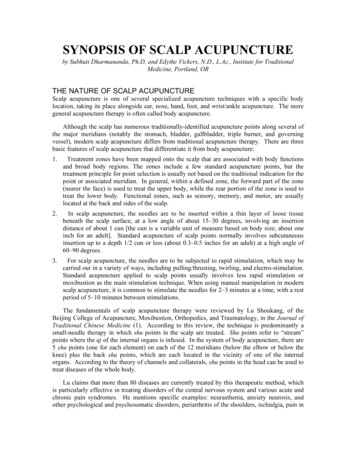

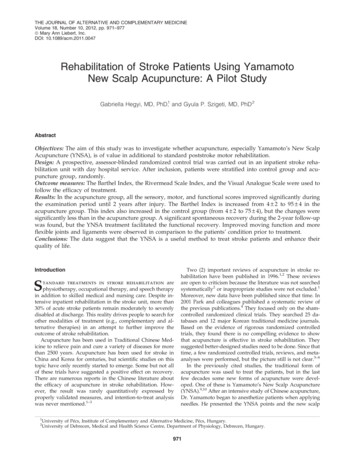

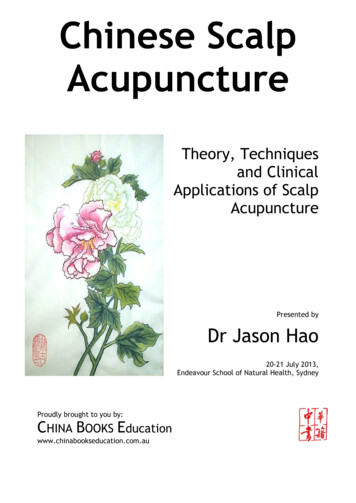
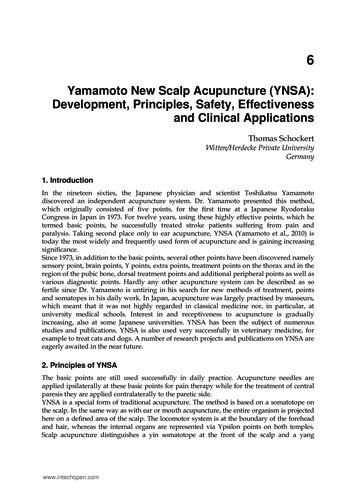
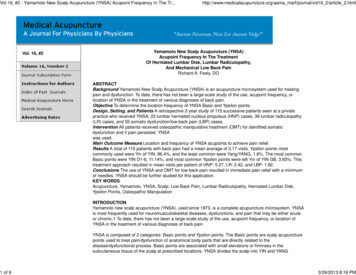
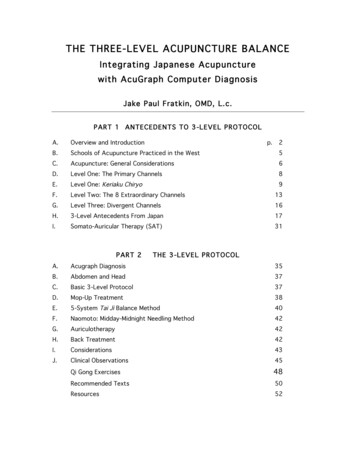
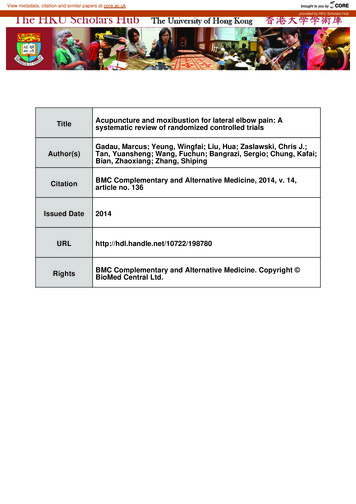
![[T] Effects of Ai Chi and Yamamoto new scalp acupuncture on chronic low .](/img/60/camilotti-bm-et-al-2015-low-back-pain-and-ai-chi-2.jpg)
